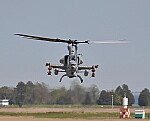Congress awaits critical Osprey crash and safety documents from Pentagon
The House Oversight Committee panel, investigating the safety and oversight of the V-22 Osprey aircraft following several fatal crashes, is still waiting for crucial data and accident reports from the Pentagon. Two committee staffers, speaking anonymously to The Associated Press, revealed that despite months of waiting, the committee has not received the necessary information.

The V-22 Osprey, which can fly like an airplane and land like a helicopter, has a troubled history with safety, maintenance, and reliability issues stretching over decades. Since 1992, twelve Osprey accidents have resulted in the deaths of 62 service members and civilians. The most recent crash occurred off the coast of Japan in November, claiming the lives of eight U.S. service members and prompting the military to ground the entire fleet. Although the aircraft began returning to service in March, it did so with flight restrictions.
The House Oversight Committee’s Subcommittee on National Security, the Border, and Foreign Affairs has specifically requested information on the wear and replacement rates of Osprey proprotor gearboxes. This component was implicated in the 2023 crash off Japan. Additionally, the committee has asked for internal crash reports, known as safety investigation board reports, which are used to identify and quickly share any safety issues within the fleet. However, these reports are not publicly available and cannot be used for disciplinary actions against crews.
So far, the committee has received about 3,500 pages of documents, but these were heavily redacted, impeding effective oversight. The staffers expressed concerns about whether Pentagon leadership has adequately monitored the Osprey program, as some issues date back over a decade and remain unresolved. Following a crash in California in 2022 that killed five Marines, the military implemented changes to prevent similar incidents. Yet, the recent fatal crash and ongoing investigations suggest a need for greater transparency and more rigorous testing, according to U.S. Rep. Glenn Grothman, a Wisconsin Republican and committee chair.
Vice Admiral Carl Chebi, head of the U.S. Naval Air Systems Command responsible for the Osprey program, is set to testify before lawmakers. The committee is particularly worried about the Pentagon's ability to sustain the Osprey program long-term, given that parts are wearing out faster than expected. Despite this, the Pentagon's recent operations and maintenance budget requests for the aircraft have been cut.
The Marine Corps plans to use the Osprey through 2050, while the Air Force Special Operations Command is already considering alternative aircraft for its missions. Meanwhile, the manufacturers of the Osprey—Bell Flight, Boeing Co., and Rolls-Royce, which supplies the engines—are facing a new lawsuit from the families of the five Marines killed in the 2022 California crash. The lawsuit alleges that these companies failed to address known parts failures and safety issues contributing to the crash. Boeing and Bell have declined to comment, citing ongoing litigation.
The most recent crash in Japan last year was the fourth in two years, cumulatively resulting in the deaths of 20 service members. The Air Force quickly attributed last year’s crash to a material problem and grounded the entire fleet—hundreds of aircraft across the Marine Corps, Navy, and Air Force. However, the Pentagon has not provided details on the specific restrictions imposed as the aircraft return to operations.
Pilots favor the V-22 Osprey for its speed and landing precision, but the series of deadly crashes, coupled with other accidents causing injuries and aircraft destruction, continue to cast a shadow over its operational future.










